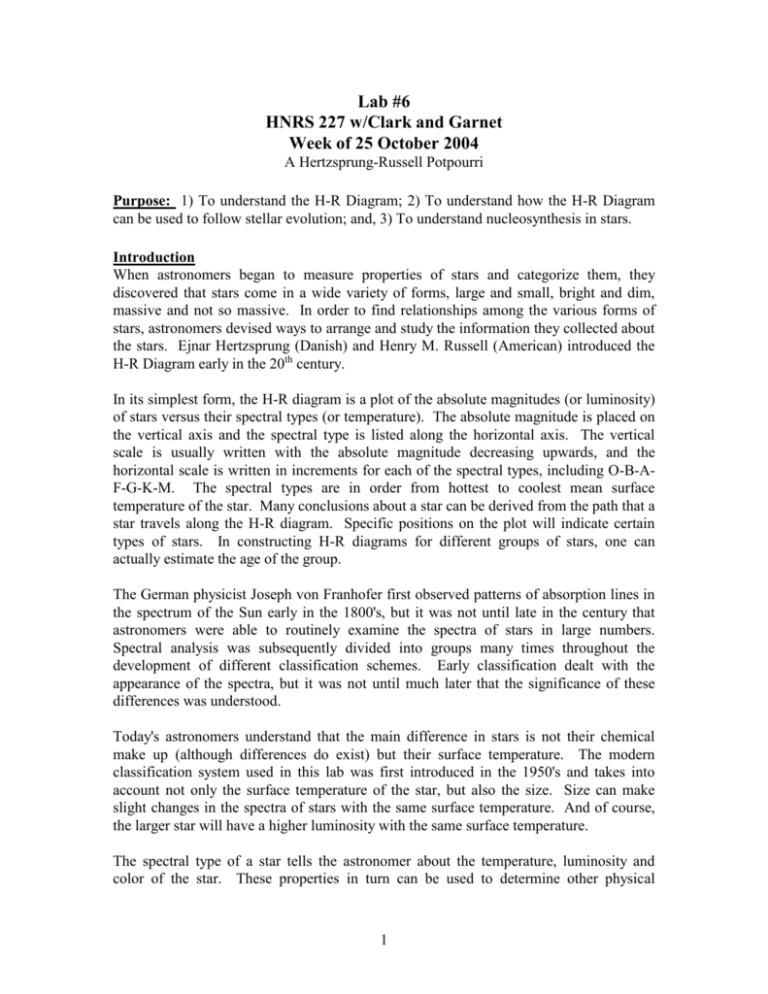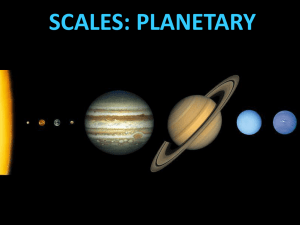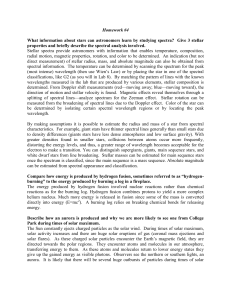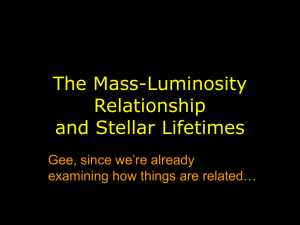Atomic Spectra
advertisement

Lab #6 HNRS 227 w/Clark and Garnet Week of 25 October 2004 A Hertzsprung-Russell Potpourri Purpose: 1) To understand the H-R Diagram; 2) To understand how the H-R Diagram can be used to follow stellar evolution; and, 3) To understand nucleosynthesis in stars. Introduction When astronomers began to measure properties of stars and categorize them, they discovered that stars come in a wide variety of forms, large and small, bright and dim, massive and not so massive. In order to find relationships among the various forms of stars, astronomers devised ways to arrange and study the information they collected about the stars. Ejnar Hertzsprung (Danish) and Henry M. Russell (American) introduced the H-R Diagram early in the 20th century. In its simplest form, the H-R diagram is a plot of the absolute magnitudes (or luminosity) of stars versus their spectral types (or temperature). The absolute magnitude is placed on the vertical axis and the spectral type is listed along the horizontal axis. The vertical scale is usually written with the absolute magnitude decreasing upwards, and the horizontal scale is written in increments for each of the spectral types, including O-B-AF-G-K-M. The spectral types are in order from hottest to coolest mean surface temperature of the star. Many conclusions about a star can be derived from the path that a star travels along the H-R diagram. Specific positions on the plot will indicate certain types of stars. In constructing H-R diagrams for different groups of stars, one can actually estimate the age of the group. The German physicist Joseph von Franhofer first observed patterns of absorption lines in the spectrum of the Sun early in the 1800's, but it was not until late in the century that astronomers were able to routinely examine the spectra of stars in large numbers. Spectral analysis was subsequently divided into groups many times throughout the development of different classification schemes. Early classification dealt with the appearance of the spectra, but it was not until much later that the significance of these differences was understood. Today's astronomers understand that the main difference in stars is not their chemical make up (although differences do exist) but their surface temperature. The modern classification system used in this lab was first introduced in the 1950's and takes into account not only the surface temperature of the star, but also the size. Size can make slight changes in the spectra of stars with the same surface temperature. And of course, the larger star will have a higher luminosity with the same surface temperature. The spectral type of a star tells the astronomer about the temperature, luminosity and color of the star. These properties in turn can be used to determine other physical 1 parameters associated with the star, including the distance, mass and even age. Thus the spectral type of a star is an important part in understanding its nature and evolution. Now remember that we are far away from stars, yet we see their light in the night sky. All that we know about stars comes from the light that travels to us. Procedure: Part 1 1. To get an idea of how we can use observations as a clue to the age of the stars that we see, we will utilize an analogy to the height and weight of humans. You will first plot the following information that is based upon the height and weight of a sample of human population. Height (inches) 60 62 64 65 66 68 70 71 72 74 2. Weight (pounds) 115 125 130 140 145 165 170 178 180 200 You will next plot the following information that is based upon the height and weight of a single human being over a lifetime. Height (inches) 21 24 36 48 54 58 60 64 66 68 68 68 3. Weight (pounds) 8 25 45 60 80 90 95 115 130 145 155 170 How do these two plots compare? How are they different? How are they similar? 2 Procedure: Part 2 4. Now login to the computer at your lab station and start the H-R Calc program. Examine the H-R diagram presented by the program. List the categories of stars that are displayed on this H-R diagram. (Careful to list them all!) 5. Find Betelgeuse on the H-R diagram by using placing the cursor over the proper star (the names will appear when you place the cursor on a star). Record the provided information about Betelgeuse including temperature, spectral class, absolute magnitude, and radius (in solar radii). Fill this information in the table provided. 6. Continue this process for the stars Deneb, Rigel, Canopus, Vega, Sirius, Rigel, Altair, Aldeberan, the Sun, Sirius B, and Barnard's Star. Fill all this information in the table provided. 7. Exit from the HR Calc program by clicking on the "File", "Close" then finally "Exit" buttons. Procedure: Part 3 7. Open the Starclock program by double clicking on the SClock shortcut icon. 8. The next screen you come to you will just bypass by clicking on any key. Please note that this program DOES NOT USE THE MOUSE! You will only use the keyboard, arrow keys and the tab key. 9. You should now be looking at a somewhat non-standard form of an H-R Diagram. Note that this has indicated both a logarithmic scale for the temperature and brightness. Furthermore, note the default settings within the START, END, STEP, DELAY, ELAPSED, TRACE, PHASES, ECLIPSE, STARS, and FILE boxes. Also, the default for the solar mass stars to be displayed is set for ALL of the standard solar mass stars to be displayed. Turn off all stars (by using the cursor and return keys) EXCEPT for the 1, 2, 5, 12 and 25 solar mass stars. 10. Now use the cursor to return the highlighted button to the RUN button. When you now hit the RUN button by using your return key on the keyboard, you will see the display represent the various mass stars on the H-R diagram. You should also see the changing years, and the changes in the positions of the stars as they leave the Main Sequence position. Although it moves fast, complete the data table provided by estimating the time that the star leaves the main sequence. You may need to use the ESCAPE key to stop the process, and you may need to return to the beginning if you missed the star's leaving the main sequence. 3 11. You are now ready to utilize the program in another mode, one that indicates the relative abundance of the elements within the star. 12. Use your arrow keys to get the EXPLORE button highlighted and hit the RETURN key. The EXPLORE button should now say EVOLVE. 13. The default settings have the 5 solar mass star as the sample. You must adjust the setting so that the 1 solar mass star is highlighted. Also, you should adjust STEPS used on screen from 2400 to 24000. 14. Now return to the RUN button with your arrow keys and engage the program by hitting your ENTER key. 15. NOTE that the age is not correct in this EXPLORE portion of the simulation. 16. Now you can examine the various changes that occur over time in the stars evolutionary path to its giant phase. 17. Enter PAGEDOWN from your keyboard and you will see the LUMINOSITY screen, depicting the changes in luminosity over time that our sun will go through. Describe the changes in luminosity over time that our sun will go through. 18. Enter PAGEDOWN from your keyboard and you will now see the surface temperature over time that our sun will go through from the main sequence to the red giant phase. Describe the changes in surface temperature over time that our sun will go through. 19. Enter PAGEDOWN from your keyboard and you will now see the radius over time that our sun will go through from the main sequence to the red giant phase. Describe the changes in radius that will take place in our sun over time. 20. Enter PAGEDOWN from your keyboard and you will now see the central chemical composition over time that our sun will go through from the main sequence to the red giant phase. List the elements in the sun and the changes that will occur over time in the relative composition. 21. Enter PAGEDOWN from your keyboard and you will now see the central chemical composition over time that our sun will go through from the main sequence to the red giant phase. Describe these changes over time for the central temperature. 22. Enter PAGEDOWN from your keyboard and you will now see the central density and how it will change over time. Describe the changes in central density over time. 4 23. Use the TAB and ARROW keys to return to the main menu. Now you should modify the chosen mass star to study by using your arrow keys to get to the 5 solar mass star simulation. 24. Repeat steps 17 through 22 for the 5 solar mass simulation, recording your results in the provided area at the end of this lab write-up. 25. Now repeat steps 17 through 22 for a 25 solar mass simulation, recording your results in the provided areas at the end of this lab write-up. 26. Record your conclusion for this lab as requested in the CONCLUSION portion of the data and answer sheet. 5 6 Experimental Data and Answer Sheet Part 1 Q1. How do the two plots of weight versus height compare to each other (differences and similarities)? Q2. How do the plots of weight versus height compare to the H-R diagram? Part 2 Q3. List the categories of stars that are displayed on this H-R diagram. (Careful to list them all!) Q4. Star Temperature Spectral Class Betelgeuse Deneb Rigel Canopus Vega Sirius Altair Aldeberan Sun Sirius B Barnard's Star 7 Absolute Magnitude Radius (solar radii) Part 3 Q5. Stellar Mass in Solar Masses 1 2 5 12 25 Time to leaving the Main Sequence Q6. Describe the changes in luminosity over time that our sun will go through. Q7. Describe the changes in surface temperature over time that our sun will go through. Q8. Describe the changes in radius that will take place in our sun over time. Q9. List the elements in the sun and the changes that will occur over time in the relative chemical composition. 8 Q10. Describe the changes over time for the central temperature of our sun. Q11. Describe the changes in central density over time for our sun. Q12. Describe the changes in luminosity over time that a 5 solar mass star will go through. Q13. Describe the changes in surface temperature over time that a 5 solar mass star will go through. Q14. Describe the changes in radius that will take place in a 5 solar mass star over time. Q15. List the elements in a 5 solar mass star and the changes that will occur over time in the relative composition. 9 Q16. star. Describe these changes over time for the central temperature of a 5 solar mass Q17. Describe the changes in central density over time for a 5 solar mass star. Q18. Describe the changes in luminosity over time that a 25 solar mass star will go through. Q19. Describe the changes in surface temperature over time that a 25 solar mass star will go through. Q20. Describe the changes in radius that will take place in a 25 solar mass star over time. 10 Q21. List the elements in a 25 solar mass star and the changes that will occur over time in the relative chemical composition. Q22. Describe these changes over time for the central temperature of a 25 solar mass star. Q23. Describe the changes in central density over time for a 25 solar mass star. Conclusion: Comment on the H-R diagram, its utility for depicting stellar evolution, and the changes that occur in stars from the main sequence to the red giant phase. 11 12 Height vs. Weight for a Very Small Sample Population 200 180 160 Weight (pounds) 140 120 100 80 60 40 20 0 0 10 20 30 40 Height (inches) 1 50 60 70 80 Height vs. Weight of an Individual over Time 200 180 160 Weight (pounds) 140 120 100 80 60 40 20 0 0 10 20 30 40 Height (inches) 2 50 60 70 80









